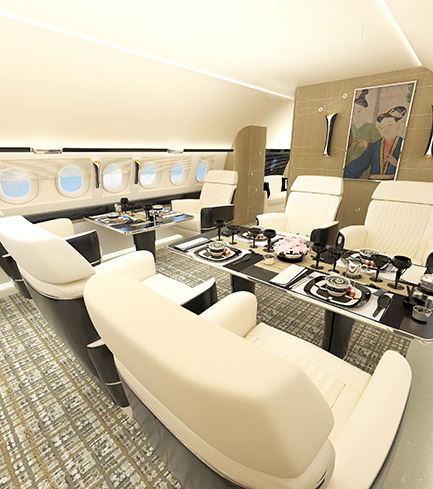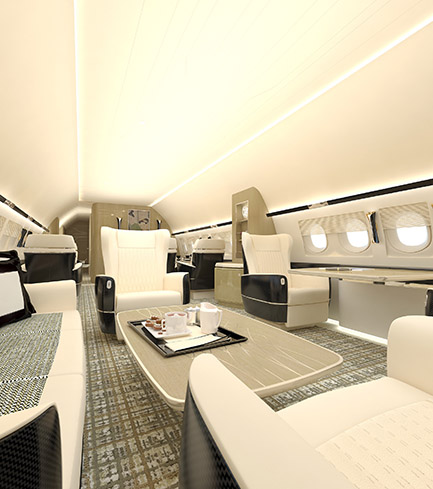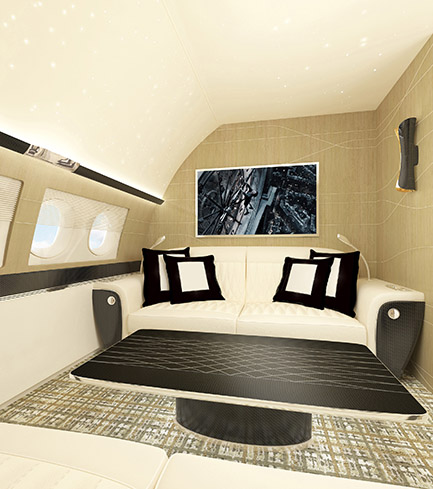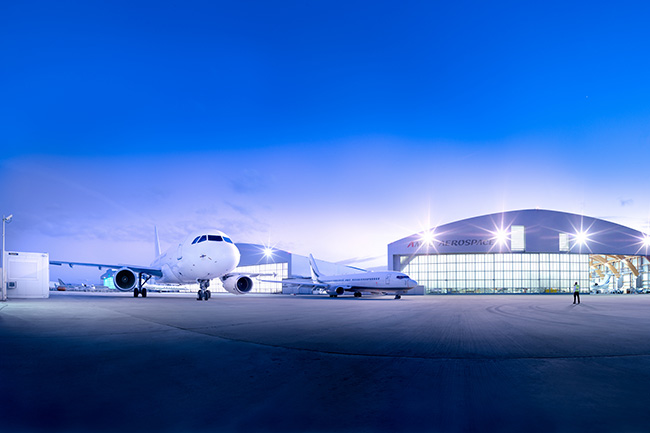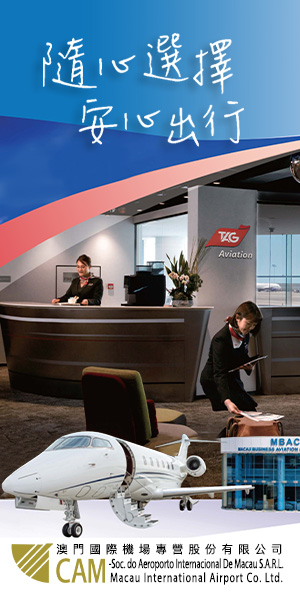It is very rare for owners of large corporate jets to allow an advance view of the interior designs for their luxurious private aircraft. But this is just what a Chinese businessman has allowed on his private two bedroomed, out of this world, Airbus ACJ319. AMAC, head quartered at Basel, Switzerland, won the contract to complete the interior for this very discerning aircraft owner. “There was no hesitation from the client and he is the only one that we’ve ever managed to receive permission from to release visual renderings in advance. It’s virtually unheard of,” said Waleed K. Muhiddin, Vice President Strategic Operations and Business Development for AMAC Aerospace.
“The client bought the aircraft brand new and through a vigorous process of evaluating completion centers with slot availability came to us. This is a real feather in our cap as he is our first Asian client,” said Muhiddin. The aircraft arrived at AMAC in November 2014 and it should be completed and re- delivered by April this year.
AMAC Aerospace is the largest privately owned MRO and Completions centre in the world with a turnover of well over a $1billion worth of project work undertaken in its short seven and half year history. “Our status at the moment is that we’re still expanding and are well underway with the construction of our fourth hangar at EuroPort Basel-Mulhouse Airport,” says Muhiddin.
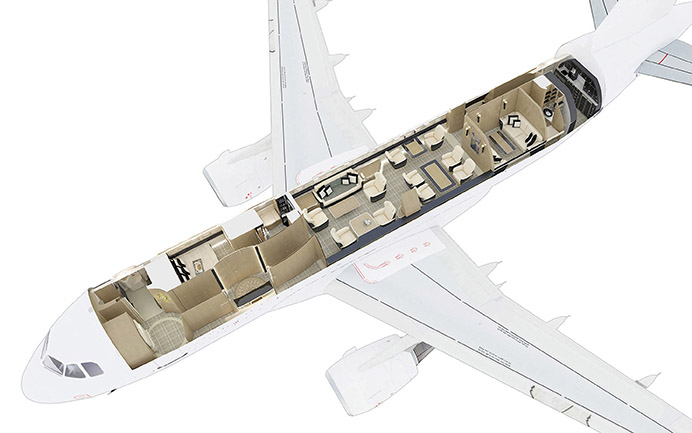
Its latest ACJ project is being EASA certificated to carry 16 passengers and three crew. The Chinese owner, who currently owns a Bombardier Global 6000, is dealing directly with AMAC rather than through intermediaries and has been personally involved in most of the design details attending meetings and presentations held in Switzerland, Paris, Beijing, Italy and New York. His brief was that he wanted something that hadn’t been seen before. He wanted to meld a very modern interior with a distinctly Chinese thread running throughout the entire cabin.
World renowned and innovative design team Cabinet Alberto Pinto, of Paris, won the contract under the leadership of Chief Designer for Aircraft Interiors, Yves Pickardt. “The kind of package that we release is much more complete than any other competitor design team,” said Pickardt. “It includes over 100 pages of information and every single detail of the cabin and every single design of each object down to magazine pouches, handles, faucets etc.” Everything is presented in 3D color visuals and a virtual walkthrough movie is made so that there are no surprises for the owner at the end of the process. “The owner knows exactly what he’s going to get,” says Pickardt.
From the outset, two years ago, the design philosophy has been, ‘less is more’ explained Pickardt. “The owner wanted something modern but not science fiction modern.” So Pickardt incorporated a lot of carbon fiber which stems from the owner’s love of sports cars, plus carbon fiber is seen as a modern technology material. The aircraft cabin is close to white although not pure white which would have been seen as too aggressive and clinical, other colors are based around pale beige. The exclusive Tai Ping silk and pure wool carpet echoes these colors with its graphic criss-cross design of white and pale beige. The beautiful wood veneer used throughout the entire cabin is Koto wood, a much prized exotic and very rare wood which is described as ‘pale grey beige’. It has a very refined parallel grain pattern and originates from tropical West Africa.
This is a really special aircraft with two bedrooms, but first things first. On entering the aircraft you find yourself in a near circular main entrance hall and greeting area. The subtle champagne gold graphic design, which runs through the entire passenger cabin, starts here with a large Feng Shui inspired planet symbol. Fine horizontal gold lines and grooves form décor lines throughout the 79 feet of the cabin with some as narrow as 1.5 millimeters. The lines are designed to cross through rings which are Chinese symbols of prosperity and success – all part of the Feng Shui aboard this aircraft.
Moving rearwards, on the right in an alcove is a ‘museum table’, a spectacular ultra modern piece beautifully brought up to date from a classic Chinese furniture design. It has a bronze base and black glossy lacquered table top. Behind this work of art a narrow strip of black horizontal venetian blinds are fitted which softens the light from the alcove’s two window apertures. On the left of the corridor is the door to the sumptuous master bedroom which carries through the Feng Shui inspired planet symbol and is complete with pale grey beige Koto wood veneers and carbon fiber bed base and trimmings.
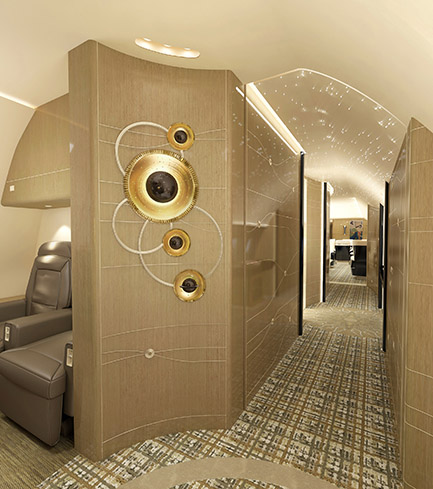 This bedroom has all the amenities you’d expect including loads of storage space, two individual fully adjustable gold plated reading lights and striking black and white square cushions to match the décor. There is total wifi connectivity here (as well as throughout the cabin) and a large wall mounted 50 inch HD LED TV monitor compatible with HD Blue Ray DVD players. The en suite bathroom has a large walk-in rain forest shower which is fully transparent on two sides. There is a teak floor and fully illuminated ceiling, but without ceiling spotlights, as stipulated by the owner. The vanity unit has an amazing black wash bowl resting on top which looks like glass but is in fact synthetic. More storage on both sides of the vanity unit, a wall mounted heated towel rail and toilet complete the luxury specification.
This bedroom has all the amenities you’d expect including loads of storage space, two individual fully adjustable gold plated reading lights and striking black and white square cushions to match the décor. There is total wifi connectivity here (as well as throughout the cabin) and a large wall mounted 50 inch HD LED TV monitor compatible with HD Blue Ray DVD players. The en suite bathroom has a large walk-in rain forest shower which is fully transparent on two sides. There is a teak floor and fully illuminated ceiling, but without ceiling spotlights, as stipulated by the owner. The vanity unit has an amazing black wash bowl resting on top which looks like glass but is in fact synthetic. More storage on both sides of the vanity unit, a wall mounted heated towel rail and toilet complete the luxury specification.
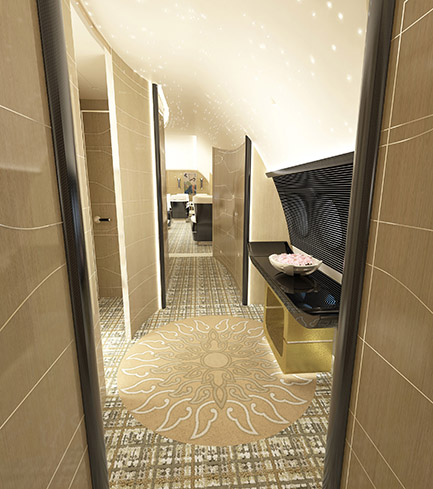 Walking rearwards along the deliberately meandering corridor on the aircraft’s deep pile carpet you arrive at the main passenger lounge. Wow! Keep reminding yourself you are on an aircraft. This is a very modern space with an opened-out near-white ceiling with minimum spotlights to give a great feeling of space and airiness. There are two pairs of high winged sumptuous leather seats arranged around two fully retracting tables either side of the aisle. All seats are fully motorized for optimum positioning and comfort. The thick white leather has fine graphic stitching and the bottom outer seat shells are made of carbon fiber and were specially designed by Alberto Ponti. To the left is a three seat divan with tables at each end. Resting on these tabletops are two specially commissioned lamps resembling dragons. They are by French artist and sculptor Guy de Rougemont who collaborated with AMAC to make these works of art airworthy. They are a particular favorite of the owner.
Walking rearwards along the deliberately meandering corridor on the aircraft’s deep pile carpet you arrive at the main passenger lounge. Wow! Keep reminding yourself you are on an aircraft. This is a very modern space with an opened-out near-white ceiling with minimum spotlights to give a great feeling of space and airiness. There are two pairs of high winged sumptuous leather seats arranged around two fully retracting tables either side of the aisle. All seats are fully motorized for optimum positioning and comfort. The thick white leather has fine graphic stitching and the bottom outer seat shells are made of carbon fiber and were specially designed by Alberto Ponti. To the left is a three seat divan with tables at each end. Resting on these tabletops are two specially commissioned lamps resembling dragons. They are by French artist and sculptor Guy de Rougemont who collaborated with AMAC to make these works of art airworthy. They are a particular favorite of the owner.
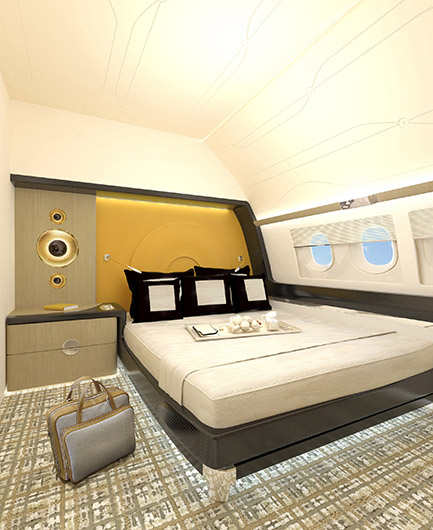 To the rear in this same area is a six seat dining space which can also be used for conferences. The leather seats have slighter lower backs while the wood tables can be electronically raised and lowered. The bulkhead wall brackets and lamps were specially designed by Alberto Pinto, the brackets are made of carbon fiber and are partly gold plated.
To the rear in this same area is a six seat dining space which can also be used for conferences. The leather seats have slighter lower backs while the wood tables can be electronically raised and lowered. The bulkhead wall brackets and lamps were specially designed by Alberto Pinto, the brackets are made of carbon fiber and are partly gold plated.
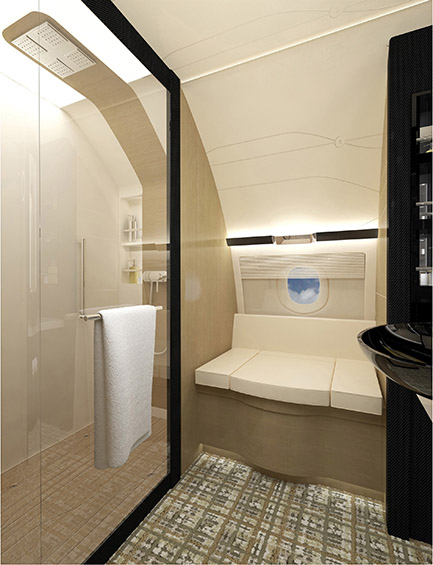 A few steps out of the main lounge and to the right is the aircraft’s second bedroom/lounge. This rear cabin has two facing sofas and a fully retractable table which can be quickly transformed into a VIP double bedroom as one of the sofas transforms into a double bed. “This will be used either by the owner’s son or other guests,” said Pickardt. It also has an adjoining VIP restroom area. In fact, if the door from the main lounge is closed and the wide sliding door from this rear cabin opened, this area can host a small party or informal meeting as there is also a recessed sofa in the corridor opposite.
A few steps out of the main lounge and to the right is the aircraft’s second bedroom/lounge. This rear cabin has two facing sofas and a fully retractable table which can be quickly transformed into a VIP double bedroom as one of the sofas transforms into a double bed. “This will be used either by the owner’s son or other guests,” said Pickardt. It also has an adjoining VIP restroom area. In fact, if the door from the main lounge is closed and the wide sliding door from this rear cabin opened, this area can host a small party or informal meeting as there is also a recessed sofa in the corridor opposite.
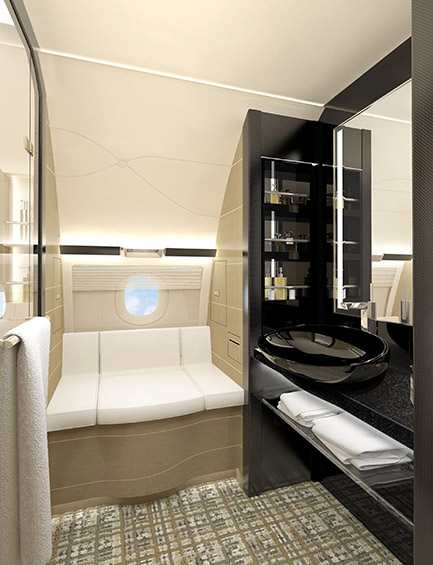 The galley at the very rear of the aircraft is very large by ACJ standards and is more like a fully fitted home kitchen. It has a specially designed heating surface which enables the owner’s personal chef to cook traditional Chinese cuisine in a wok. The kitchen is full of storage compartments and has ovens so that western food can also be produced.
The galley at the very rear of the aircraft is very large by ACJ standards and is more like a fully fitted home kitchen. It has a specially designed heating surface which enables the owner’s personal chef to cook traditional Chinese cuisine in a wok. The kitchen is full of storage compartments and has ovens so that western food can also be produced.
As for connectivity the passenger satellite communications aboard the aircraft are acquired through an SBB antenna says Stéphane Bibler, AMAC’s Project Manager for the aircraft. There are several large TV monitors installed throughout the aircraft varying from 42 to 50 inch. The connectivity system is engineered to enable the charging and display of all apple devices as standard, while interface ports are installed to display every type of external device to the IFE system. Over the two years of the planning process, because of the speed of technological progress, improvements to the original specification have already been made in respect of improving the wireless connection of apple devices to the large monitors, says Bibler.
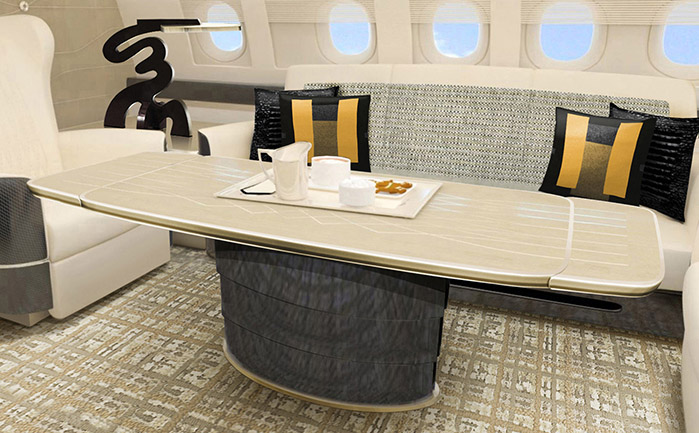 On the ramp the aircraft is protected by an on board camera security system. It also has alarmed doors and access panels which can be monitored and locked from the flight deck.
On the ramp the aircraft is protected by an on board camera security system. It also has alarmed doors and access panels which can be monitored and locked from the flight deck.
A fundamental part of AMAC’s philosophy for all their corporate jet completion programs is to design a user-friendly low maintenance cabin regime to avoid having to remove major cabin structures to solve minor cabin electrical glitches. AMAC’s electrical experts install special connectors to avoid excessive down-time and expense in gaining access to the aircraft’s hidden electrical looms.
